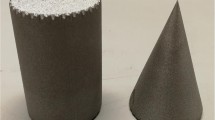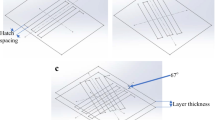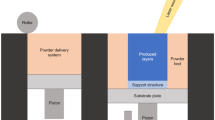Abstract
In this study, parts were fabricated using variations of laser power, scanning speed, and hatch spacing (volumetric energy density (VED)) to understand the effect of processing parameters on the structure and properties of 316L stainless steel. It was observed that parts with good microstructural integrity and properties (hardness, porosity, and density) were obtained when using VEDs between 40 and 100 J/mm3. Also, VED was valuable when comparing the extent of consolidation and unfused/unmelted powders (porosity). The individual printing parameters offered a better understanding of the microstructure evolution, part density, and hardness of the material when compared with the VED. Also, it was shown that the relative beam spot size to the hatch spacing creates unique conditions that result in either a melt track offset or overlap which dictates the energy requirement for the creation of a part with good qualities. Melt track overlaps require low power while melt track offsets require high power to create parts with good qualities (density, porosity, and hardness). In addition, it was observed that the hatch spacing dominates the scanning speed in determining part porosity while the scanning speed dominates the hatch spacing in determining part density. The individual printing parameters had a significant effect on the morphology, size, and spatial distribution of columnar and cellular subgrain structures. Higher laser power and high scanning speed resulted in coarser, well-defined cellular and columnar subgrains with relatively low hardness. Also, increasingly hatch spacing resulted in finer subgrain structures with dense columnar structures and sparsely distributed cellular structures.

















Similar content being viewed by others
Data Availability
The authors confirm that the supporting data in this journal is presented within the manuscripts itself and will make raw data presented in this study available upon request to the corresponding author (S. Boakye-Yiadom).
References
Guo N, Leu MC (2013) Additive manufacturing: technology, applications and research needs. Front Mech Eng 8(3):215–243
Harrysson OLA, Cansizoglu O, Marcellin-little DJ, Cormier DR, West HA (2008) Direct metal fabrication of titanium implants with tailored materials and mechanical properties using electron beam melting technology. Mater Sci Eng: C 28(3):366–73
Al-Tamimi AA, Fernandes PRA, Peach C, Cooper G, Diver C, Bartolo PJ (2017) Metallic bone fixation implants: a novel design approach for reducing the stress shielding phenomenon. Virtual Phys Prototyp 12(2):141–151
Yan Q, Dong H, Su J, Han J, Song B, Wei Q, Shi Y (2018) A review of 3D printing technology for medical applications. Engineering 4:729–742
Zuback JS, DebRoy T (2018) The hardness of additively manufactured alloys. Materials 11(11):2070
Manfredi D et al (2013) Direct metal laser sintering: an additive manufacturing technology ready to produce lightweight structural parts for robotic applications. Metall Ital 105(10):15–24
Jahangir MN, Mamun MAH, Sealy MP (2018) A review of additive manufacturing of magnesium alloys. AIP Conference Proceedings 1980(1):030026
Jiang J, Ma Y (2020) Path planning strategies to optimize accuracy, quality, build time and material use in additive manufacturing: A review. Micromachines 11(7):633
Yusuf SM, Gao N (2017) Influence of energy density on metallurgy and properties in metal additive manufacturing. Mater Sci Technol (United Kingdom) 33(11):1269–1289
Yusuf S, Chen Y, Boardman R, Yang S, Gao N (2017) Investigation on porosity and microhardness of 316L stainless steel fabricated by selective laser melting. Metals (Basel) 7(2):64
Kruth J, Deckers J, Yasa E, Wauthle R (2012) Assessing and comparing influencing factors of residual stresses in selective laser melting using a novel analysis method. Proceedings of the Institution of Mechanical Engineers, Part B: Journal of Engineering Manufacture 226(6):980–991
Liu Y, Yang Y, Wang D (2016) A study on the residual stress during selective laser melting (SLM) of metallic powder. Int J Adv Manuf Technol 87(1–4):647–656
Kurzynowski T, Gruber K, Stopyra W, Kuźnicka B, Chlebus E (2018) Correlation between process parameters, microstructure and properties of 316 L stainless steel processed by selective laser melting. Mater Sci Eng A 718(January):64–73
Xu W, Brandt M, Sun S, Elambasseril J, Liu Q, Latham K, Xia K, Qian M (2015) Additive manufacturing of strong and ductile Ti-6Al-4V by selective laser melting via in situ martensite decomposition. Acta Mater 85:74–84
Kamath C, El-Dasher B, Gallegos GF, King WE, Sisto A (2014) Density of additively-manufactured, 316L SS parts using laser powder-bed fusion at powers up to 400 W. Int J Adv Manuf Technol 74(1–4):65–78
Yadroitsev I, Yadroitsau I, Yadroitsev I (2009) Selective laser melting: direct manufacturing of 3D-objects by selective laser melting of metal powders. Appl Catal B Environ 75(3–4):229–238
Kusuma C (2016) The effect of laser power and scan speed on melt pool characteristics of pure Titanium and Ti-6Al-4V alloy for selective laser melting. Dissertation, Kakatiya University, India
Raza T (2020) Process understanding and weldability of laser-powder bed fusion manufactured alloy. Dissertation, University West, Trollhättan
Sun Z, Tan X, Tor SB, Yeong WY (2016) Selective laser melting of stainless steel 316L with low porosity and high build rates. Mater Des 104:197–204
Childs THC, Hauser C, Badrossamay M (2004) Mapping and modelling single scan track formation in direct metal selective laser melting. CIRP Ann Manuf Technol 53(1):191–194
Pavlov M, Doubenskaia M, Smurov I (2010) Pyrometric analysis of thermal processes in SLM technology. Phys Procedia 5(PART 2):523–531
Tang X, Zhang S, Zhang C, Chen J, Zhang J, Liu Y (2020) Optimization of laser energy density and scanning strategy on the forming quality of 24CrNiMo low alloy steel manufactured by SLM. Mater Charact 170(September):110718
Yakout M, Elbestawi MA, Veldhuis SC (2019) Density and mechanical properties in selective laser melting of Invar 36 and stainless steel 316L. J Mater Process Technol 266(October 2018):397–420
Scipioni Bertoli U, Wolfer AJ, Matthews MJ, Delplanque JPR, Schoenung JM (2017) On the limitations of volumetric energy density as a design parameter for selective laser melting. Mater Des 113:331–340
Yap CY, Chua CK, Dong ZL, Liu ZH, Zhang DQ, Loh LE, Sing SL (2015) Review of selective laser melting: materials and applications. Appl Phys Rev 2(4):041101
Cherry JA, Davies HM, Mehmood S, Lavery NP, Brown SGR, Sienz J (2014) Investigation into the effect of process parameters on microstructural and physical properties of 316L stainless steel parts by selective laser melting. Int J Adv Manuf Technol 76(5–8):869–879
Galarraga H, Lados DA, Dehoff RR, Kirka MM, Nandwana P (2016) Effects of the microstructure and porosity on properties of Ti-6Al-4V ELI alloy fabricated by electron beam melting (EBM). Addit Manuf 10:47–57
Thijs L, Verhaeghe F, Craeghs T, Van Humbeeck J, Kruth JP (2010) A study of the microstructural evolution during selective laser melting of Ti-6Al-4V. Acta Mater 58(9):3303–3312
Weng F, Gao S, Jiang J, Wang JJ, Guo P (2019) A novel strategy to fabricate thin 316L stainless steel rods by continuous directed energy deposition in Z direction. Addit Manuf 27(March):474–481
Cooke A, Slotwinski J (2015) Properties of metal powders for additive manufacturing: A review of the state of the Art of Metal Powder Property Testing. Additive Manufacturing Materials: Standards, Testing and Applicability 21–48
Chao J, Capdevila C, Serrano M, Garcia-Junceda A, Jimenez JA, Miller MK (2014) Effect of α-α’ phase separation on notch impact behavior of oxide dispersion strengthened (ODS) Fe20Cr5Al alloy. Mater Des 53:1037–1046
Vrancken B, Thijs L, Kruth JP, Humbeeck JV (2012) Heat treatment of Ti6Al4V produced by selective laser melting: microstructure and mechanical properties. J Alloys Compd 541:177–185
Gong H, Rafi K, Gu H, Starr T, Stucker B (2014) Analysis of defect generation in Ti–6Al–4V parts made using powder bed fusion additive manufacturing processes. Addit Manuf 1–4:87–98
Zhang B, Li Y, Bai Q (2017) Defect formation mechanisms in selective laser melting: a review. Chin J Mech Eng (Engl Ed) 30(3):515–527
EOS (2016) Stainless steel for 3D printing. https://www.eos.info/03_system-related-assets/material-related-contents/metal-materials-and-examples/metal-material-datasheet/stainlesssteel/ss-316l_9011-0032_m100_material_data_sheet_flexline_12-17_en.pdf
Ocylok S, Alexeev E, Mann S, Weisheit A, Wissenbach K, Kelbassa I (2014) Correlations of melt pool geometry and process parameters during laser metal deposition by coaxial process monitoring. Phys Procedia 56(C):228–238
Peen R (2017) 3D printing of 316L stainless steel and its effect on microstructure and mechanical properties. Dissertation, Montana Tech
Ghasri-Khouzani M, Peng H, Attardo R, Ostiguy P, Neidig J, Billo R, Hoelzle D, Shankar MR (2018) Direct metal laser-sintered stainless steel: comparison of microstructure and hardness between different planes. Int J Adv Manuf Technol 95(9–12):4031–4037
Saeidi K, Gao X, Zhong Y, Shen ZJ (2015) Hardened austenite steel with columnar sub-grain structure formed by laser melting. Mater Sci Eng A 625:221–229
Hebert RJ (Feb. 2016) Viewpoint: metallurgical aspects of powder bed metal additive manufacturing. J Mater Sci 51(3):1165–1175
Ziętala M, Durejko T, Polański M, Kunce I, Płociński T, Zieliński W, Łazińska M, Stępniowski W, Czujko T, Kurzydłowski KJ, Bojar Z (2016) The microstructure, mechanical properties and corrosion resistance of 316 L stainless steel fabricated using laser engineered net shaping. Mater Sci Eng A 677:1–10
Funding
The authors received funds from the Natural Sciences and Engineering Research Council of Canada (NSERC) for this investigation.
Author information
Authors and Affiliations
Contributions
All authors were involved in the detailed analysis and discussions presented in this paper. A. Eliasu drafted the manuscript which was reviewed and edited by A. Czekanski and S. Boakye-Yiadom.
Corresponding author
Ethics declarations
Ethical approval
Not applicable.
Competing interests
The authors declare no competing interests.
Additional information
This submission is original and is not being submitted for publication elsewhere.
Publisher’s note
Springer Nature remains neutral with regard to jurisdictional claims in published maps and institutional affiliations.
Rights and permissions
About this article
Cite this article
Eliasu, A., Czekanski, A. & Boakye-Yiadom, S. Effect of laser powder bed fusion parameters on the microstructural evolution and hardness of 316L stainless steel. Int J Adv Manuf Technol 113, 2651–2669 (2021). https://doi.org/10.1007/s00170-021-06818-9
Received:
Accepted:
Published:
Issue Date:
DOI: https://doi.org/10.1007/s00170-021-06818-9




